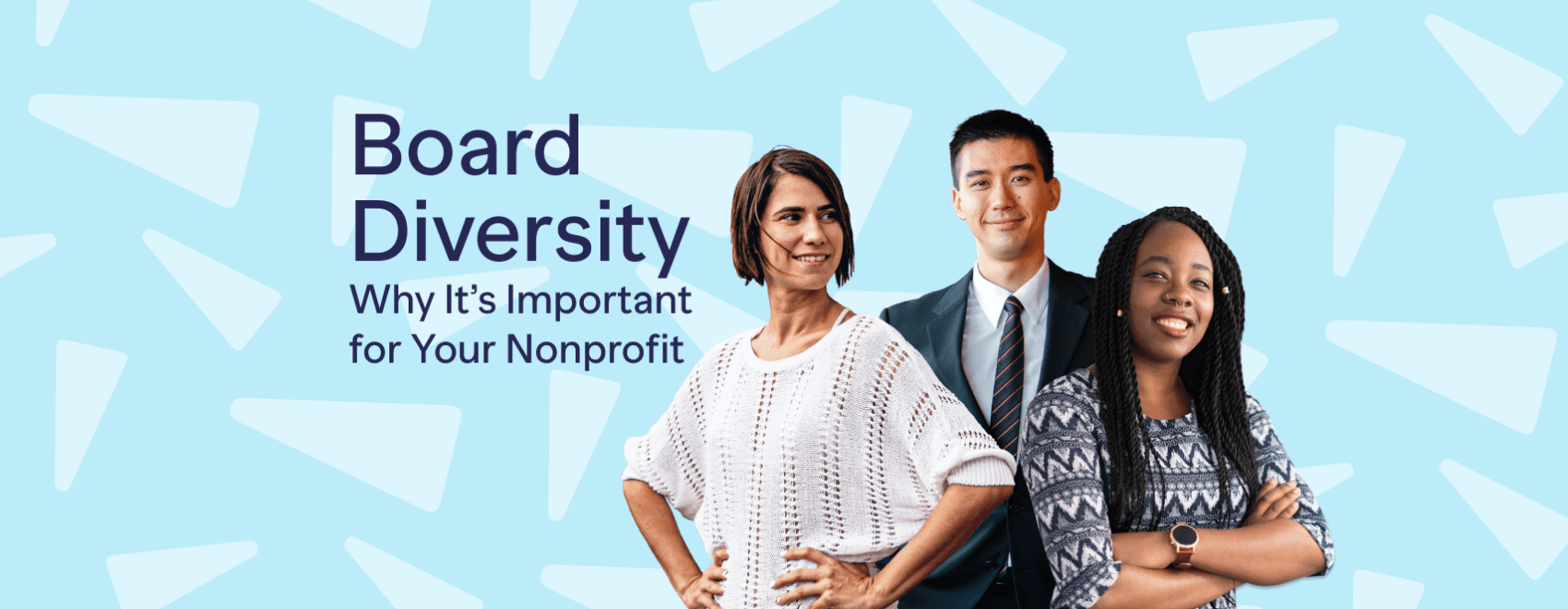Times, they are a-changin. Across the globe, the workforce is evolving and becoming more diverse in for-profit and non-profit sectors. For example, in the United States, Hispanic and Asian-American populations are anticipated to double by 2060, while the African American population is set to rise from 13.1 to 14.7 percent of the overall population in the same time frame.
If your organization is far from diverse, don’t worry, you’re not alone.
Especially at the leadership level, nonprofits are prone to being stuck in their ways. Research shows that most board members at nonprofits are white, older, and male. While gender parity has been improving significantly in recent years, racial and ethnic diversity is lagging, and so are age demographics. On average, nonprofit boards are 78.6% white, and well over 80% are older than 40. If your own nonprofit board can relate to these grim stats, we feel you.
So, what can you do about it? Lots! While equity and diversity are complicated topics, your nonprofit can take concrete steps to become more inclusive. Diversifying your leadership team makes your nonprofit more imaginative and boosts advocacy and fundraising. Let’s dig in and see what that looks like.
What is diversity?
Let’s start with the basics. Diversity differentiates people and groups, whether in terms of ethnicity, gender, economic background, religion, age, or sexual orientation.
Expanding equity and diversity goes way beyond tolerance. It’s about honoring all those differences in inclusive and supportive ways, so that your organization reflects the general makeup of society.

For example, studies show that nonprofit workplaces tend to have systemic “white advantage.” This basically means that people of color often work for White-run boards for less money than their White peers. Expanding diversity works toward dismantling barriers like white advantage, so that all the different members of your nonprofit team are equally valued participants.
Why is diversity essential for your nonprofit?
Aside from just being the right thing to do, focusing on diversity and inclusion can help your nonprofit reap some generous rewards down the line.

- Diversity means better ideas. The more voices and perspectives your nonprofit can bring to the table, the bigger the payoff for your cause. Different life experiences give groups richer insight and more unique perspectives, which leads to better, bolder, less conventional solutions.
- Diversity helps reflect the community. When your leadership team can relate to the communities it serves, it’s better equipped to understand that community’s needs, have access to necessary resources, and evaluate the policies your nonprofit employs. For example, if everyone on your board is affluent, how well can they really understand the financial situation of single working mothers? Speaking from experience means a lot.
- Diversity improves fundraising performance. Different demographics at your nonprofit impact your fundraising engagement in different ways. Younger people, for example, are more likely to ask directly for donations and contribute more networking contacts than older folks, while women are more active fundraisers than their male counterparts. So, take advantage of all the unique quirks that different demographics have to offer by recruiting as many as you can.
- Diversity improves advocacy efforts. More than half of nonprofit organizations work hard to educate legislators on important social and economic concerns that impact their communities. If increasing public and governmental awareness of key issues is important to your nonprofit, it makes a major difference when your advocates can speak from their own experience. When your board members have the ear of policymakers and stakeholders, the messages they deliver should reflect the perspectives of the groups in your community.
- Diversity boosts retention. High turnover is a common theme among nonprofits. Studies indicate that a sense of belonging has a huge impact on who stays in an organization and who takes off for more inclusive pastures. If your staff feels valued, your nonprofit has a much better shot at attracting and keeping top talent.
How to diversify your board
Diversity and inclusion training in organizations is all the rage right now, but it’s been a thing for a long time. You’ve probably sat through a version of diversity training at some point in your career.
Get ready for some real talk: diversity training is shown to be pretty much useless. Especially at big organizations, this sort of major training session is often just a low-cost, shiny cover for a serious lack of inclusivity, and it does almost nothing to effect actual change.
Experts argue that you can forget all about that tedious diversity seminar that nobody wants to sit through, anyway, and instead push for real change. Your staff will thank you!

#1: Make inclusion a key component of your nonprofit’s cause.
Since every organization is unique, it’s always helpful to set aside time to sit down with your team and brainstorm together about your organization’s current diversity strengths and weaknesses. Talk about your overall cultural awareness and how to go about addressing your inclusivity goals.
A good place to start is expanding your mission statement, organizational policies, and fundraising efforts to include advancing diversity across your community. If you’re working on behalf of vulnerable populations, for example, demonstrate your dedication to inclusiveness by stating explicitly that your work benefits people from all ethnic and social backgrounds.
If you’re a school or a faith-based organization, adjust your mission statement to include all groups, especially historically underrepresented and minority populations. The Denver Foundation has some great examples of how to word your mission statements to reflect a dedication to diversity, among other helpful resources.
During onboarding and orientation sessions, make it crystal clear to new recruits that advocating on behalf of diversity is an integral part of your nonprofit’s culture.
#2: Rethink your recruiting process to remove bias
If you want to leverage all the invaluable resources that a diverse candidate pool has to offer, take a good look at your recruiting strategies. Obviously, it’s important to prioritize merit when selecting future board members. Just make sure you’re doing it without bias.
- Be transparent. Whether you’re discussing benefits or workplace culture, make sure that you share all the information a candidate needs to know what’s up at your organization. It helps them make an informed decision that’s based on trust. Elon Musk, for instance, makes it abundantly clear that his people work a minimum of 80 hours–if you don’t like it, no problem, just don’t apply at Tesla!

So, let’s say your nonprofit board is quietly (or not so quietly!) critical of members who take advantage of parental leave. Be upfront about it. The last thing you want is a new mother feeling guilty about her family responsibilities and bad-mouthing your organization after she takes off for a more flexible job.
- Seek out diverse job boards. There are plenty of job boards that focus specifically on underrepresented minorities. Whether you want to be more inclusive of age, ethnicity, or disability status (or all three!), it’s not hard to connect with a wider pool of potential candidates.
- Don’t rely exclusively on referrals. Look, we get it. Your CEO’s daughter is brilliant with people and Tom from accounting has mad fundraising skills, so it just makes sense to promote them to your board. While this sort of thing happens all the time, it’s seriously hurting your diversity efforts. No matter how committed you are to inclusivity, unless your workforce is already diverse, employee referrals will just result in more of the same. Check those job boards and reach out to different members of your network to cast your net as wide as you can.
- Mind your language. When writing up job posts, make sure you’re using neutral, inclusive language. It’s usually unintentional, but when you’re browsing job boards, how often do you come across phrases like “he or she” or references to perks like gym memberships?
If you identify as neither “he” nor “she,” or if you’re not able to use gym equipment, that type of thing can sound pretty tone deaf and alienate some stellar candidates. When asking for a BA in accounting, for example, keep in mind that you’re limiting your applicants to those that pursued traditional education paths. Not everyone had the money to attend a four-year college, but that doesn’t mean they haven’t been crunching numbers like a pro at a top organization for the past twenty years.
#3: Be flexible.
When assessing the perks and benefits of working at your nonprofit, keep in mind that not all benefits address everyone’s needs.
For example, studies show that when applying to jobs, women prefer yoga classes to office pizza parties, and that they rank free day-care much more highly than men do. Consider people from all walks of life. What options and resources can you offer to folks with elderly dependents, or very young children, or mobility issues?
#4: Celebrate differences.
To ensure that all the members of your board feel appreciated for who they are, take a step beyond diversity to focus on inclusion. This means that differences aren’t just tolerated–or, worse, that they’re just a box to check–but that they are truly valued and celebrated.
Lots of people feel uncomfortable sharing critical aspects of their identities at work, a tendency that Harvard Business Review calls “identity cover.” For instance, a gay woman may avoid bringing her partner to your group’s annual summer picnic, while a staunch Republican might conceal his political background because he’s afraid of being judged harshly.

While you obviously cannot and should not force people to divulge these details, it’s totally possible to create a nurturing environment so that team members feel welcome to open up and be valued for who they really are.
If someone volunteers to share their religious background, for example, it’s an opportunity to learn and grow as an organization by recognizing holidays other than Christmas and Easter. If another board member feels comfortable discussing their cultural background, view it as a lucky chance for your team to become more educated, sensitive, and self-aware. Share a meal from their home country, or chat about wedding traditions over lunch.
Encourage Diversity, See More Fundraising Success
In most cases, members of nonprofit boards are excited to learn about other perspectives, backgrounds, and ways of doing things. Expanding diversity in your leadership team makes your organization stronger, culturally richer, and better at fundraising, too!
Here at RallyUp, we’re ready to help you grow your organization with the best fundraising experience you’ve ever had. As you breeze into the future, ditch the paper and pencil and let our online fundraising platform take care of all the small and big stuff for you.
With a smart, intuitive, easy-to-follow process that your donors will love, RallyUp empowers your board members to tackle that next big fundraiser–together.
